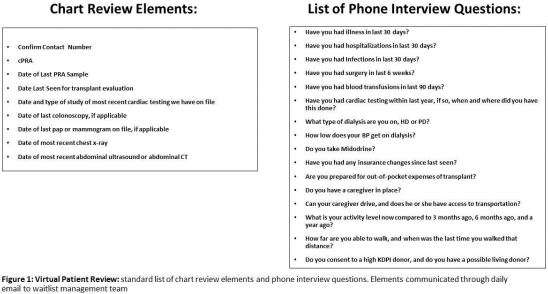Virtual Encounters: Robust Methods to Manage Your Active Waitlist
Transplant, MUSC, Charleston, SC.
Meeting: 2018 American Transplant Congress
Abstract number: A376
Keywords: Kidney, Waiting lists
Session Information
Session Name: Poster Session A: Quality Assurance Process Improvement
Session Type: Poster Session
Date: Saturday, June 2, 2018
Session Time: 5:30pm-7:30pm
 Presentation Time: 5:30pm-7:30pm
Presentation Time: 5:30pm-7:30pm
Location: Hall 4EF
Introduction: The ability to ensure all patients are transplant ready and do not have outstanding issues that would diminish post-transplant outcomes is challenging with an active waitlist of >500 patients. The aim of this study was to evaluate if a virtual patient assessment program using EMR chart review plus patient phone interviews can allow for prioritization of a large waitlist.
Methods: Waitlist multidisciplinary team developed a standard list of chart review elements and phone interview questions
Waitlist prioritization calls began April 2017 and a new waitlist coordinator was established on June 11, 2017. We considered our baseline active waitlist starting on May 19, 2017. Chart review and phone contact interview data were collected from April 2017-October 2017. Data was categorized as HLA, cardiovascular, health maintenance and psychosocial issues and were communicated the next day via email to the waitlist team.
Results:The baseline active waitlist contained 561 patients, 76% (429/561) of patients were able to be evaluated during the observation period. HLA issues were identified in 29 patients, specifically out of date serum samples. A total 6% (25/429) of patients had new CV issues identified during their call and 7% (30/429) identified for re-evaluation were found to have new CV issues. Health maintenance issues were identified in 6% (27/429) of patients during calls and 36% (155/429) during re-evaluation visits. Also 10% (41/429) had psychosocial issues identified during phone interviews that would impact their ability to proceed to transplant (4 patients had multiple reasons, financial 54% (22/41); transportation 22% (9/41); 10% (4/41); 17% (7/41)). Patient listings were changed in 164 patients during the observed time period, 14% (24/164) were changed within the 10 days of the virtual review.
Conclusions: For the first time in our program's history we were able to assess and stratify our waitlists readiness for transplant and allocate multidisciplinary resources to target high risk patients. With continued follow-up we will avoid calling in patients who are not transplant ready thus minimizing waste of resources and enhancing the patient experience.
CITATION INFORMATION: Curry K., Zimmerman S., Cassidy D., Gray S., Rao V., Rohan V., Pilch N., Milling A., Curry L. Virtual Encounters: Robust Methods to Manage Your Active Waitlist Am J Transplant. 2017;17 (suppl 3).
To cite this abstract in AMA style:
Curry K, Zimmerman S, Cassidy D, Gray S, Rao V, Rohan V, Pilch N, Milling A, Curry L. Virtual Encounters: Robust Methods to Manage Your Active Waitlist [abstract]. https://atcmeetingabstracts.com/abstract/virtual-encounters-robust-methods-to-manage-your-active-waitlist/. Accessed December 28, 2025.« Back to 2018 American Transplant Congress

